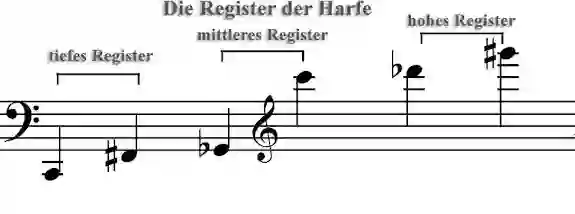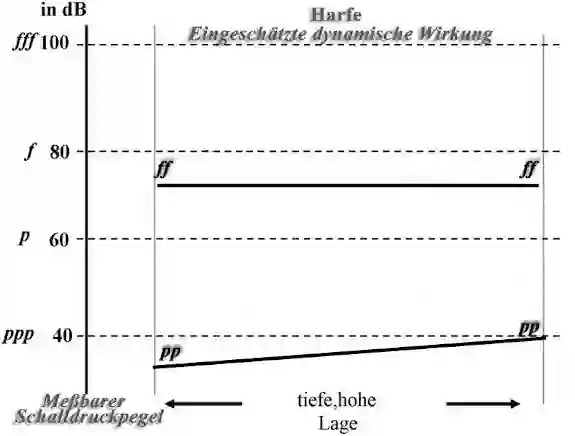Sound character of the Harp - Philipp Dangas
Register table of the harp
The sound of a plucked string vibrating is determined by the first 6 partials of the natural scale, which are contained in each tone as the fundamental and associated overtones. At the same time, the point at which the string is plucked or plucked is of particular importance.
The strings of the harp are usually plucked in the middle, which produces the greatest sonority. Of particular importance for the tonal and technical treatment of the harp are the strong resonance and the considerable resonance of its strings. The sound scale of the harp is in turn divided into 3 registers, which result from the technical structure of the instrument, namely the following:
Summary of the individual registers of the harp
- 1.The low register
- which has strings that produce a very full and resonant sound.
- 2.The middle register
- with its full, luminous and warm tones (the most sonorous range).
- 3.The high register
- with its bright and rather hard sound, due to the short and strongly tensioned strings.
As part of the „symphonic world music“
The harp should create color contrast, especially in places with particular luminosity.
Download size: 60.4 kilobytes
Table summary of the Sound character of the Harp
The following table lists the registers and tones of the harp briefly described. This includes the high register, the middle register and the low register described.
Dynamic effect of the harp
Sheet music for the dynamic table of the harpThe specification of the degrees of strength of musical dynamics is made clear in the dynamic table. In addition to the sound pressure scale measured in decibels [dB], the degrees of strength of musical dynamics are given on the left, which can be understood as "objective" degrees.
To the right of the decibel scale is a chart showing the different degrees. It shows the estimated dynamic effect over the entire tonal range of the instrument. The dynamic effect (volume) as judged (perceived) by the listener.
An example: In the low register of the trumpet, the dynamic range between pianissimo [pp] 46 decibels [dB] and fortissimo [ff] 82 decibels [dB] = 36 decibels [dB]. In the high register, the range is 8 decibels [dB]. The estimated values can deviate more or less from the "objective" ones.
Understandably, the deviations between the instruments are different. The “objective” levels of intensity piano pianissimo [ppp]= 40 decibels [dB], p=60 decibels [dB] etc. mentioned above enable the composer to make a prediction of the dynamic effects of different instruments that are sounding at the same time.
Table summary of harp dynamic range
The following table shows the achievable dynamic range of the harp shown. The span is the difference between the fortissimo and the Pianissimo in the same pitch.

The register table of a harp in a large representation
- high register
- Pretty hard but very bright
- middle register
- Most resonant area. Full, warm tones
- low register
- Full and strongly lingering, yet powerful and sharply contoured.

The dynamic chart of a harp
Internal search function
| Name | Value | Delete |
|---|